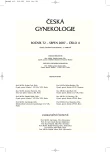Predikcia intrauterinnej rastovej retardácie plodu pomocou markerov integrovaného testu
Prediction of Intrauterine Growth Retardation Using the Integrated Test Markers
Objective:
Author’s objective was to ascertain the option for prediction of intrauterine growth retardation using the integrated test markers on the population of pregnant women in Košice city.
Design:
Retrospective, longitudinal, multicenter study.
Setting:
2nd Department of Obstetrics and Gynecology University of P. J. Šafárik, Košice, Slovak Republic.
Methods:
The study group comprised 578 pregnant patients of 2nd Department of Obstetrics and Gynecology, in the period from 01. 11. 2001 until 31. 01. 2005 for integrated test consisting of (examination of the gestation age using CRL, concentration of PAPP-A, NT, AFP, uE3, hCG). Information on birth weight, gender, gestation age at the time of delivery, occurrence of preeclampsia and other pregnancy complications were found in 578 patients retrospectivelly. We have designed two outcome criteria: 1. intrauterine growth retardation <5th fetal weight percentile – IUGR 5 – and intrauterine growth retardation <10th percentile – IUGR 10. In order to make use of the summary information provided by the markers, we have used the method of logistic regression to identify statistically significant predictors of individual binary outcomes (IUGR 5 and IUGR 10). First we developed an equation based on all available predictors. Statistically insignificant predictors were indikátogradually eliminated from the model (Stepwise regression) until the final model remained, for which a ROC curve was developed and values of sensitivity, specificity, positive and negative predictive values at 5% FP (false positivity) were calculated.
Results:
The final model of IUGR 5, containing only statistically significant markers of integrated test achieved – at 5% FP level and 95% specificity level – a 34.8% sensitivity, 24.1% positive and 97.0% negative predictive value - in prediction of birth weight under 5th percentile with respect to gestation age and gender. The final model of IUGR 10, containing only statistically significant markers achieved – at 5% FP level and 95% specificity level – a 36.4% sensitivity, 32.1% positive and 95.8% negative predictive value - in prediction of birth weight under 10th percentile with respect to gestation age and gender.
Conclusion:
Our results, as well as the results of other studies, lead to the conclusion, that in spite of the multitude of biochemical markers and various options for their combination with ultrasound markers, so far it has been impossible to find a combination which would meet the following criteria: 1. high sensitivity and specificity at low false positive values and high positive and negative predictive value, 2. application as a screening method for prediction of intrauterine growth retardation and preeclampsia in unselected population of pregnant women.
Key words:
prediction, IUGR, integrated test, markers
Autoři:
P. Urdzík; R. Dankovčík; A. Ostró; I. Lazár
Působiště autorů:
II. gynekologicko-pôrodnícka klinika LF UPJŠ a FN L. Pasteura, Košice
prednosta prof. MUDr. A. Ostró, CSc.
Vyšlo v časopise:
Ceska Gynekol 2007; 72(4): 268-279
Kategorie:
Původní práce
Souhrn
Cieľ:
Cieľom tejto práce bolo zistiť na populácii gravidných žien mesta Košice možnosť predikcie intrauterinnej rastovej retardácie pomocou markerov integrovaného testu.
Typ štúdie:
Retrospektívna longitudinálna multicentrická štúdia.
Názov a sídlo pracoviska:
II. gynekologicko-pôrodnícka klinika LF UPJŠ a FN L. Pasteura, Košice, Slovenská republika.
Materiál a metodika:
Vyšetrovaný súbor tvorilo 578 tehotných pacientok II. gynekologicko-pôrodníckej kliniky od 01. 11. 2001 do 31. 01. 2005 za účelom vyšetrenia v integrovanom teste ( CRL, vyšetrenie koncentrácie PAPP- A, NT, vyšetrenie koncentrácie AFP, uE3, hCG). Údaje o pôrodnej hmotnosti plodov, ich pohlaví, o gestačnom týždni v čase pôrodu, výskyte preeklampsie a iných komplikáciách tehotnosti boli zistené u 578 pacientok retrospektívne. Vytvorili sme dve cieľové premenné: 1. intrauterinná rastová retardácia pod 5. percentilom hmotnosti plodov – IUGR 5 a intrauterinná rastová retardácia plodu pod 10. percentilom – IUGR 10. S cieľom využiť súhrnú informáciu, ktorú markery majú, bola využitá metóda logistickej regresie, ktorou boli identifikované štatisticky významné prediktory jednotlivých binárnych cieľových premenných (IUGR 5 a IUGR 10). Najprv bola zostrojená rovnica, ktorá využíva všetky dostupné prediktory. Štatisticky nevýznamné prediktory boli postupne vylučované z modelu (Stepwise regression) až zostal finálny model, pre ktorý bola zostrojená ROC krivka a určená senzitivita, špecificita, pozitívna a negatívna prediktívna hodnota pre nami určenú 5% FP.
Výsledky:
Finálny model IUGR 5, ktorý obsahuje len štatisticky významné markery integrovaného testu dosiahol pri 5% falošnej pozitivite a 95% špecificite 34,8% senzitivitu, 24,1% pozitívnu a 97,0% negatívnu prediktívnu hodnotu v rámci predikcie pôrodnej hmotnosti plodu pod 5. percentilom vzhľadom ku gestačnému veku a pohlaviu plodu. Finálny model IUGR 10, ktorý obsahuje len štatisticky významné markery integrovaného testu dosiahol pri 5% falošnej pozitivite a 95% špecificite 36,4% senzitivitu, 32,1% pozitívnu a 95,8% negatívnu prediktívnu hodnotu v rámci predikcie pôrodnej hmotnosti plodu pod 10. percentilom vzhľadom ku gestačnému veku a pohlaviu plodu.
Záver:
Z našich výsledkov, ako aj z výsledkov iných štúdií však vyplýva, že aj napriek veľkému množstvu biochemických markerov a rôznym možnostiam ich kombinácie s ultrazvukovými markermi sa doteraz nepodarilo nájsť takú kombináciu, ktorá by spĺňala nasledujúce podmienky: 1. vysoká senzitivita a špecificita pri nízkej falošnej pozitivite a vysokej pozitívnej a negatívnej prediktívnej hodnote, 2. využitie ako skríningovej metódy v rámci predikcie intrauterinnej rastovej retradácie a preklampsie v neselektovanej populácii gravidných žien.
Kľúčové slová:
predikcia, IUGR, integrovaný test, markery
Štítky
Dětská gynekologie Gynekologie a porodnictví Reprodukční medicínaČlánek vyšel v časopise
Česká gynekologie

2007 Číslo 4
Nejčtenější v tomto čísle
- Poloha matky při porodu a poranění perinea
- Predikcia intrauterinnej rastovej retardácie plodu pomocou markerov integrovaného testu
- Scientometrické ukazatele (citační index, impakt faktor, Hirschův index) a hodnocení vědecké práce v medicíně
- Okultní ruptura análního sfinkteru během porodu – současné znalosti
